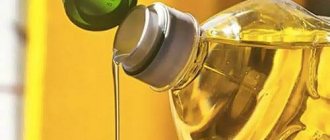Diesel fuel (diesel fuel) is a liquid product that is actively used as a solvent in technology and household applications, and for refueling cars. The main disadvantage of a universal product is that it can heavily contaminate shoes and clothes, leaving a greasy mark that is quite difficult to get rid of.
When clothes are contaminated with gasoline or diesel fuel, many do not try to find out how to properly remove the stain or remove the unpleasant odor. If you get your overalls, fashionable jeans or a warm jacket dirty, you shouldn’t discard the items; you can easily wash them and remove the pungent “aroma” of fuel forever.
Thanks to some tips, improvised materials, and folk remedies, it is possible to remove not only a fresh stain, but also one that has already become firmly established on the fabric.
How to get rid of old stains and fuel traces
Proven folk methods, improvised means and household chemicals will help remove old stains. It is better to remove contaminants from gasoline and diesel fuel immediately, otherwise the liquid will be absorbed into the fabric and fixed in it.
The best remedies for old stains:
- Gasoline. When the marks have dried and become embedded in the material, it is recommended to use household gasoline, but not automobile gasoline. As for household products, they have a high degree of purification. It is sold in all hardware stores. Take a piece of cloth, soak it in gasoline and wipe off the mark. The direction of movement is towards the center from the edges, so as not to increase the area of contamination. To manipulate, you will have to change the flap several times. Continue rubbing until the dirt comes off. After this, rinse with water and machine wash.
- Stain remover. Wash overalls, jeans or a shirt with old stains in powder, rub traces of diesel fuel by hand. Dilute two caps of a good quality stain remover in three liters of water. Soak the items for thirty minutes, rinse and wash with powder.
- Paper . A hot iron and white paper will help remove stubborn greasy marks. Wash and dry the product. Place paper on both sides of the dirty area and iron it with a medium-heat iron. After performing the heat treatment, an oily imprint will appear on the surface of the paper. Replace the paper and continue ironing until the dirt comes off.
Professional stain remover
By following the recommendations, you can remove traces of gasoline, diesel fuel, and also overcome the bad smell.
The best laundry detergents
A powerful way to combat the smell of diesel fuel is to ventilate in the open air. Given the fact that this substance is volatile, the vapors disappear within two weeks. As for dirt, it is very easy to remove grease.
Top 4 effective ways:
- Washing powder. Soiled clothes will become fresh and clean again if you wash them using powders such as Tide and Ariel. You should not use a washing machine; hand washing in a basin works best. Hang the product in the fresh air, dry, and ventilate.
- Dishwashing gel . The fight against traces of diesel fuel and gasoline at home will be crowned with success if you use regular dishwashing liquid. Dissolve 3 tablespoons of gel in a bowl of warm water, shake with your hands, foam will appear. Immerse clothes or a towel in the soapy solution, leave for an hour, then wash by hand.
- Starch . The essence of the technique is that a special active mixture is used, where the base ingredient is potato starch. Recipe: thoroughly mix a few drops of ammonia, turpentine, adding one teaspoon of starch. An old toothbrush will come in handy; you should use it to apply the paste to dirty areas, rubbing in smooth, soft, gentle movements. Leave for two hours, wash with powder.
- Heat treatment . The specificity of the technology is to use a hot iron, spending a minimum amount of effort and time. Algorithm of action: wash the oily mark with powder, place a rag underneath, iron the item with a heated iron. Having completed the manipulation, you will be able to make sure that all the smell is gone and the stain has disappeared. It is important to remember that this option cannot be used for delicate products.
Stain removers
Special means
Don’t know how to wash gasoline from clothes using improvised means? It couldn't be easier. The first folk recipe that will come to the rescue is dishwashing liquid, which must be applied to the stained area or soaked in water with the addition of a product. We recommend using a good quality composition that can quickly cope with contamination.
Soak the item of clothing for a couple of hours, then wash in high temperature water with the addition of washing powder. Machine wash is also a good option. The method is extremely effective if the contamination is treated immediately after detection - after drying, it is quite difficult to clean gasoline traces.
Another recipe involves using chalk. Crush a small amount of chalk and pour it onto the contaminated area, leaving it for a couple of hours. Then shake the chalk off your clothes. If the remedy turns out to be ineffective, the procedure can be repeated a couple of times. If you don't have chalk on hand, use table salt.
After cleaning, wash the item of clothing as usual. To combat dirt, it is good to use a special soap called “Antipyatin”, which can easily be found in the store on the shelf with household chemicals. Simply lather any petrol traces you find, leave for a while, then wash the product.
To get rid of the stain, clothes must be washed after using special products.
If you do not have free time and (or) the opportunity to cope with the task yourself, you can always use the services of dry cleaners. For a fairly modest fee, they can quickly and without consequences eliminate both unpleasant and greasy stains. This is especially true if you spilled liquid on a product made of genuine leather, which is very susceptible to chemical reagents.
Fighting unpleasant odor
After the stains from clothes and shoes are removed, you need to take measures to get rid of the terrible, pungent smell.
- Toothpaste . Mint paste will help remove the harshest aroma. Dilute 2 tablespoons of toothpaste in 200 ml of water and pour over the washed areas of the product. A simpler option is to spread a thick layer on the area where the gasoline got in. Leave in this condition for at least two hours, rinse thoroughly and dry in fresh air.
- Special conditioner. The most reliable and effective way is to rinse in a concentrated fabric conditioner designed for washing clothes. Air dry, rinse again and hang outside again.
- Prolonged ventilation. A simple and quick method that removes the odors of diesel fuel and gasoline. The washed product can simply be hung in the fresh air and left for several days. This will allow the most pungent aroma to dissipate.
- Kerosene. No matter how strange it may sound, but thanks to kerosene you can eliminate the smell of diesel fuel. Use exclusively household kerosene, add it to a bowl of cold water and soak the clothes for thirty minutes. Rinse and hang outside.
How to eliminate fuel odor from a vehicle
Cars are an integral part of modern life; it is not a luxury at all, but a convenient, fast, comfortable way of transportation. Despite the comfort in the cabin, soft seats, if an unpleasant, pungent smell of fuel appears inside, staying in it becomes uncomfortable. In this case, you should find out how to remove odors from the car interior.
The presence of a fuel smell in the cabin can cause harm and damage to the health of not only the driver, but also the passengers. There is a risk of developing the following symptoms if you inhale the vapor for a long time:
- nausea;
- headache;
- weakness;
- irritability;
- dizziness.
To avoid such a clinical picture, it is advisable to learn ways to help remove odors from the interior.
Quality wash with shampoo
Popular, effective techniques:
- Quality wash with shampoo. Checking its source will help get rid of fuel vapors. It is necessary to inspect the trunk and carpets to look for contamination from diesel fuel and gasoline. Having discovered a place of contamination, it is recommended to wet clean the trunk and interior using car shampoo. You can use the services of a car wash, which uses professional detergents.
- Coffee . Ground coffee will help neutralize the strong “aroma”; sprinkle it on the stains. This product contains valuable oils that absorb external odors. The cheapest variety will do; you don’t have to buy expensive coffee.
- Dish balm. Gasoline and diesel fuel are oily chemical products that leave behind greasy residues. If you find dirt on rugs or upholstery, it is recommended to use a regular dishwashing detergent. The secret is that washing balms contain a unique chemical formula that can break down fats. They contain aromatic fragrances, they will help eliminate the unpleasant odor. The best method is to pour the liquid onto the stain, leave it for a while, then rinse with water.
- Baking soda . The area of contamination is treated with sodium bicarbonate, the duration of exposure is no more than a day. Sprinkle the dry powder onto the dirty spot and vacuum it after twenty-four hours; this will help remove the smell from the car interior.
- Vinegar . A proven grandmother's method that will help clean the trunk and interior of a vehicle. Pour 9% vinegar into a spray bottle and spray over the contaminated area. Ventilate during the day.
In addition to the options listed, simple ventilation will help get rid of unpleasant odors. Open the hood, doors, trunk to create a draft. The optimal duration of such ventilation is all night.
Thus, removing stains from gasoline and diesel fuel is very simple; improvised, inexpensive products available in every home will do. All proposed options and methods are distinguished by accessibility, safety, and high efficiency.
Use these recipes very carefully, taking into account the type of fabric and degree of contamination. To avoid serious problems with clothing, you should use diesel fuel and gasoline more carefully.
How to get rid of the persistent smell of gasoline on your favorite clothes?
A beauty in the garage always requires attention, the cost of which is specific contamination of clothes. Why, sometimes after a regular visit to a gas station the question arises of how to remove the smell of gasoline that has soaked into your favorite trousers. Unfortunately, this issue is not resolved very quickly, and there are a number of mistakes that you need to be wary of when trying to wash soiled items.
Useful tips
Before you start removing diesel fuel from clothes, you need to remember some nuances:
- It will be easier to wash off the fuel if it has not yet ingrained itself into the fabric, so you must begin removing the stain immediately after detecting the stain;
- You need to wash off diesel fuel correctly: treating the dirt from the edges and gradually moving towards the center of the stain;
- When removing this type of pollution, it is important to remember your own safety: diesel fuel is a flammable substance, so work should not be carried out near an open fire;
- If all the methods for removing diesel fuel have been used, but no result has been achieved, you can use an old but proven method - ironing the item
What should you not do?
First you need to find out what can worsen the situation so that you don’t accidentally go down the wrong path. There are only two serious problems that an inexperienced person can make.
- Wash things in an automatic machine. In this way, it will not be possible to get rid of the unpleasant odor quickly, but the washing unit will absorb unpleasant fumes and will certainly transfer them during the subsequent washing of a new batch of clothes. You will have to accept that washing will only be done by hand.
- The desire to instantly get rid of stains often turns to bleach. This should not be done until the smell of gasoline remains on clothing, since the two active substances will immediately enter into a chemical reaction. The result is toxic fumes and your poor health.
In addition, there is another sad news: you can’t get rid of the smell quickly. To wash it, you will have to carry out several lengthy procedures, so first prepare other things from your wardrobe for today's wear, and only after that begin to silently suffer from gasoline fumes.
Safety precautions
Gasoline is a flammable and caustic substance, so safety precautions must be observed when working with it. It is also important when trying to get rid of its vapors and smell. The following rules must be followed:
- Under no circumstances should you wash off petroleum products with chlorine bleach, because the substances react by releasing toxic fumes.
- Do not wash items stained with fuels and lubricants in a washing machine. The smell is well absorbed into the drum and rubber seals, and during subsequent washes the clothes will smell of it.
- You need to wear protective gloves, because fuels and lubricants are absorbed into the skin, and this can cause a severe allergic reaction.
- It is forbidden to work in clothing that has been exposed to gasoline near an open flame, as this substance is highly flammable.
If the smell is not very intense
Sometimes you can get lucky and the amount of fuel on the fabric will be negligible. If the stains are not noticeable at all and only the smell indicates traces of the problem, the item does not need to be washed. This type of fuel contains volatile compounds, which themselves can erode in fresh air. To do this, you need to perform a number of actions.
- Hang clothes in the fresh air, preferably in a draft. Then the weathering process will take place faster.
- You can get rid of an unpleasant odor even faster by pointing a household fan at the problem area. The air flow will circulate at a higher speed, and evaporation will take place in a shorter period of time.
- It’s great if you can hang things out in the frosty air. The acquired freshness will not remind you of the trouble that happened.
Despite a small ingress of fuel, clothing can be completely restored no faster than in a few days, or even weeks.
Are you going to hang clothes in your room? Make sure no one in the family has a fuel allergy. In addition, some people get headaches from the evaporation - the fumes are poisonous after all. It’s best not to take risks and remove things from the living space.
If the stain is large
Large traces of gasoline can be washed off. This must be done in a basin; the water temperature should be selected depending on the fabric. You can use store-bought detergents for washing. Tide and Ariel are good choices - high-quality powders with a strong odor. For less delicate fabrics, choose dishwashing liquids that work more actively with odors and active substances.
For large or ancient stains, it is imperative to divide the washing into two stages: soak in the evening and leave to get wet until the morning, then finish washing and dry the item in the same way as airing. At the same time, continue working in the morning after changing the water. The night one absorbs the chemical composition of gasoline.
There are also a number of folk recipes that will help remove stains and thereby get rid of the smell.
- Add 2-3 drops of turpentine and ammonia to 1 tablespoon of starch, mix thoroughly and apply the mixture with a toothbrush to the dirty surface. Rub lightly, then wash as usual.
- Rub with laundry soap, which removes foreign odors well. Next, rinse and wash with powder for greater effect.
- Baking soda is great for removing odors. Dip a napkin in a concentrated solution of soda, apply the solution exactly to the right place and after half an hour wash it with powder, after rinsing the item.
- If the item is heavily soiled, mix equal parts boron, soda and vinegar, soak for 15 minutes and wash in warm water. Rinse thoroughly so that the active mixture does not change the color of the fabric.
- You can fill a spray bottle with ammonia and apply it evenly to the surface. Then lightly rub, rinse and wash with usual detergents.
- The original method is to wrap the item in newspapers, then pack it in a plastic bag and leave it there for a week. Thin and porous paper will absorb the smell well, after which all that remains is to ventilate the clothes in a draft.
Is it possible to do without washing?
There are 3 options for removing technical odors from things without washing:
- Ventilation. Clothes are left outside (balcony) for several days or a week, depending on the size of the stain. If possible, hang it in a draft. Frosty air is especially good at eliminating the strong smell of gasoline.
- If hanging clothes outside is not possible, you need to cover the stain on all sides with newsprint. It will absorb both the greasy stain and the aroma. It is better to change the newspaper periodically. After several days, when the smell noticeably decreases or disappears, clothes should be hung up for airing, at least in the apartment.
- You can remove the persistent smell of gasoline without ventilating or washing clothes. To do this, rub the stain thoroughly with washing powder, leave for a few minutes, and then rinse. You need to put a rag on this place and iron it with a maximally heated iron (depending on the type of fabric) until the stain is completely dry.
Gasoline, in principle, does not wash well, so even when using the washing method, you should first use one of the indicated methods. This will significantly increase the chances of saving the clothes.
Machine washing of fabrics from gasoline stains must be preceded by preliminary soaking in a solution of water with detergents or other household cleaning products:
- How to remove the smell of gasoline from clothes with washing powder? The problem area is treated with a “mush” of the product. Leave for 30.0-40.0 minutes. After this time, the item of clothing is washed in warm water with a solution of the same powder, and then machine washed.
- How to remove gasoline stains with dishwashing detergent? Instead of a “mush” of washing powder, detergent is used, but further measures correspond to the previously indicated instructions.
- How to remove a stain with soda? Prepare a solution in the following proportion: 4.0 tablespoons of soda per glass of warm water. Treat the stain, leave for up to 40.0 minutes, rinse, and machine wash.
- How to remove a gasoline stain with a mixture of starch, turpentine, and ammonia? The mixture is made up in the following proportions: 1.0 teaspoon/3.0 drops/3.0 drops. It should be rubbed into the problem area with a short-bristled brush. The rest of the steps are obvious.
- How to remove fuel stains with mustard powder? Mustard solution successfully removes odor. The disadvantage is represented by the duration of soaking - from 2.0 to 4.0 hours.
- You can remove gasoline stains with citric acid. Dosed application will quickly eliminate the smell of gasoline from clothes and prepare clothes for the main wash. However, consequences may occur in the form of changes in the color and texture of the fabric.
Thermal method
Gasoline's ability to evaporate can be used for good. If you are not allergic to fumes, you can use an iron to speed up the process of removing the unpleasant odor. In this case, you can give up trying to wash the stain for a couple of days. To do this you need:
- Wipe the problem area thoroughly with washing powder;
- rinse the area;
- lay out the ironing cloth, cover with a clean cloth (rag);
- iron with a very hot iron (depending on the quality of the fabric, select the highest temperature setting).
After this, the smell will be removed with the vapor, and there will be no stain left either.
Local cleaning methods
Any petroleum refining product can leave dense stains that are difficult to remove. They are removed in the same way as greasy stains.
In the first minutes after the oil product gets on the fabric, you should sprinkle the resulting stain with salt, then clean it with a brush, and repeat the procedure. Salt prevents the oily substance from penetrating deeper, and it is easier to wash items treated with sodium chloride.
Do the same when using talc or crushed chalk. It is important to treat the area around the stain as well . Afterwards the item is washed without much effort.
Gasoline stains can also be treated with a solvent. It is applied to the entire stain and the surrounding area, left for half an hour, then washed off.











